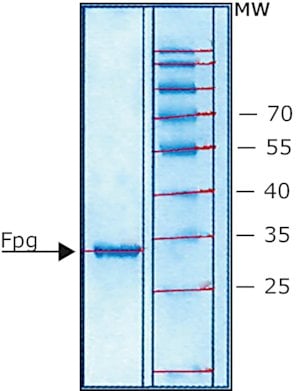Fpg Protein from Escherichia coli

Fpg Protein from Escherichia coli structure
|
Common Name | Fpg Protein from Escherichia coli | ||
|---|---|---|---|---|
| CAS Number | 78783-53-6 | Molecular Weight | N/A | |
| Density | N/A | Boiling Point | N/A | |
| Molecular Formula | N/A | Melting Point | N/A | |
| MSDS | USA | Flash Point | N/A | |
|
Laser for treatment of aphthous ulcers on bacteria cultures and DNA.
Photochem. Photobiol. Sci. 11(9) , 1476-83, (2012) Low-intensity red lasers are proposed for treatment of oral aphthous ulcers based on biostimulative effects. However, effects of low-intensity lasers at fluences used in clinical protocols on DNA are controversial. The aim of this work was to evaluate the eff... |
|
|
Accumulation of lipids and oxidatively damaged DNA in hepatocytes exposed to particles.
Toxicol. Appl. Pharmacol. 274(2) , 350-60, (2014) Exposure to particles has been suggested to generate hepatosteatosis by oxidative stress mechanisms. We investigated lipid accumulation in cultured human hepatocytes (HepG2) and rat liver after exposure to four different carbon-based particles. HepG2 cells we... |
|
|
Vitamins at physiological levels cause oxidation to the DNA nucleoside deoxyguanosine and to DNA--alone or in synergism with metals.
Mutagenesis 27(4) , 511-7, (2012) Vitamins with antioxidant properties have the ability to act as pro-oxidants, inducing oxidative damage and oxidative stress as opposed to preventing it. While vitamin supplements are commonly consumed, the scientific evidence for their health beneficial effe... |
|
|
Can standard genotoxicity tests be applied to nanoparticles?
J. Toxicol. Environ. Health A 75(13-15) , 800-6, (2012) Experiments were conducted to determine the validity of two common genotoxicity testing procedures, the comet assay and the micronucleus (MN) test, when applied to nanoparticles (NP). The comet assay is used to detect strand breaks (SB) induced in cellular DN... |
|
|
Host cell reactivation of gene expression for an adenovirus-encoded reporter gene reflects the repair of UVC-induced cyclobutane pyrimidine dimers and methylene blue plus visible light-induced 8-oxoguanine.
Mutagenesis 28(5) , 507-13, (2013) Previously, we have reported the use of a recombinant adenovirus (Ad)-based host cell reactivation (HCR) assay to examine nucleotide excision repair (NER) of UVC-induced DNA lesions in several mammalian cell types. The recombinant non-replicating Ad expresses... |
|
|
Development of antibiotic resistance and up-regulation of the antimutator gene pfpI in mutator Pseudomonas aeruginosa due to inactivation of two DNA oxidative repair genes (mutY, mutM).
FEMS Microbiol. Lett. 324(1) , 28-37, (2011) Prevention and correction of oxidative DNA lesions in Pseudomonas aeruginosa is ensured by the DNA oxidative repair system (GO). Single inactivation of mutT, mutY and mutM involved in GO led to elevated mutation rates (MRs) that correlated to increased develo... |
|
|
Anti-genotoxic potential of bilirubin in vivo: damage to DNA in hyperbilirubinemic human and animal models.
Cancer Prev. Res. (Phila.) 6(10) , 1056-63, (2013) The bile pigment bilirubin is a known antioxidant and is associated with protection from cancer and cardiovascular disease (CVD) when present in too strong concentrations. Unconjugated bilirubin (UCB) might also possess anti-genotoxic potential by preventing ... |
|
|
Thermodynamics of the multi-stage DNA lesion recognition and repair by formamidopyrimidine-DNA glycosylase using pyrrolocytosine fluorescence--stopped-flow pre-steady-state kinetics.
Nucleic Acids Res. 40(15) , 7384-92, (2012) Formamidopyrimidine-DNA glycosylase, Fpg protein from Escherichia coli, initiates base excision repair in DNA by removing a wide variety of oxidized lesions. In this study, we perform thermodynamic analysis of the multi-stage interaction of Fpg with specific ... |
|
|
Structural and biochemical studies of a plant formamidopyrimidine-DNA glycosylase reveal why eukaryotic Fpg glycosylases do not excise 8-oxoguanine.
DNA Repair (Amst.) 11(9) , 714-25, (2012) Formamidopyrimidine-DNA glycosylase (Fpg; MutM) is a DNA repair enzyme widely distributed in bacteria. Fpg recognizes and excises oxidatively modified purines, 4,6-diamino-5-formamidopyrimidine, 2,6-diamino-4-hydroxy-5-formamidopyrimidine and 8-oxoguanine (8-... |
|
|
Structural and biochemical analysis of DNA helix invasion by the bacterial 8-oxoguanine DNA glycosylase MutM.
J. Biol. Chem. 288(14) , 10012-23, (2013) MutM is a bacterial DNA glycosylase that serves as the first line of defense against the highly mutagenic 8-oxoguanine (oxoG) lesion, catalyzing glycosidic bond cleavage of oxoG to initiate base excision DNA repair. Previous work has shown that MutM actively ... |